
|
HYBRID EQUINES - DONKEY/ASS X ZEBRA |
Equid (horse, donkey, zebra) hybrids are well known and some are bred commercially. The generic term for a zebra hybrid with a horse, pony, donkey or ass is a zebroid. The generic term for a hybrid of a zebra with any type of donkey or ass is a zebrass.
The usual naming convention for hybrids is a "portmanteau word" comprising first part of male parent's name + second part of female parent's name
|
Father |
Mother |
Offspring |
|
Zebra |
Donkey (jenny/jennet) |
Zebrass, Zedonk, Zebronkey, Zonkey, Zebadonk, Zebryde, Zenkey (Japan), Hamzab (Israel) |
|
Donkey (jack) |
Zebra |
Zebret, Donkra |
Zebras that are hand-reared or reared with domestic horses or donkeys can become tame enough to be led, ridden or used as draught animals. Those raised with horses or donkeys may prefer to mate with horses or donkeys rather than with zebras.

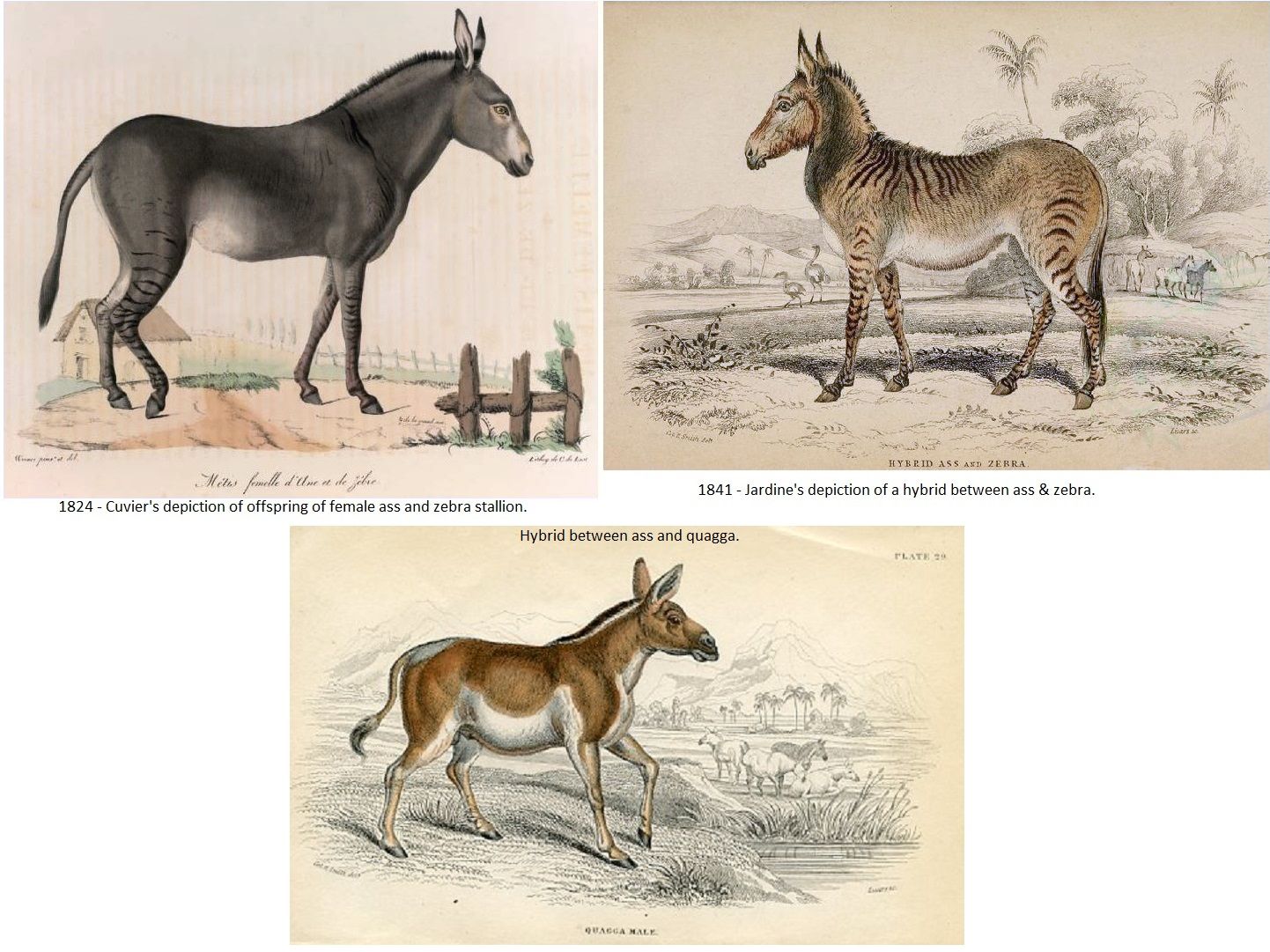
Zedonks (zebronkeys, zonkeys, zebadonks, zebrydes) are zebra stallion/donkey hybrids. Zebrets are donkey stallion/zebra mare hybrids and are rare. Other names have been used: zenkey (Japan) and hamzab (Israel). Generic terms are zebrass, zebra mule and zebra hinny. Zebrasses resemble donkeys with a striped pattern overlaided on the donkey's background colour. Usually there is clear striping on the legs, a dorsal stripe. There may be facial stripes and indistinct stripes on the body. According to Dorcas McClintock in "A Natural History Of Zebras," a hybrid foal from a Somali wild ass bred to a mountain zebra mare had 2 transverse shoulder stripes, leg bands and zebra-like ear stripes. Piebald zebrasses are produced when a zebra is crossed to a piebald donkey.
Zebra/ass hybrids have been recorded since at least the 1850s. According to the Illustrated Natural History by the Rev JG Wood (1853, 1874): Between the zebras and the domestic ass several curious Mules have been produced, and may be seen in the collection of the British Museum. It is worthy of notice that wherever a cross breed has taken place, the influence of the male parent seems to be permanently impressed on the mother, who in her subsequent offspring imprints upon them some characteristics of the interloper. In his "The Variation Of Animals And Plants Under Domestication", Darwin wrote: "I have seen, in the British Museum, a hybrid from the ass and zebra dappled on its hinder quarters. [...] Many years ago I saw in the Zoological Gardens a curious triple hybrid, from a bay mare, by a hybrid from a male ass and female zebra". Zebrass males are generally sterile in spite of Darwin's report of that horse mare x zebrass stallion hybrid (is it possible the stallion was a quagga rather than a hybrid?).
Midland Mail, 3rd December 1904: The zebras are back again in the old home in the London Zoo. . . . fine specimen of the Somali wild ass, a curious hybrid zebra from the Transvaal, and examples of Grant zebra and the so-called Burchell s zebra. Sadly we don't know what the curious hybrid was bred from.
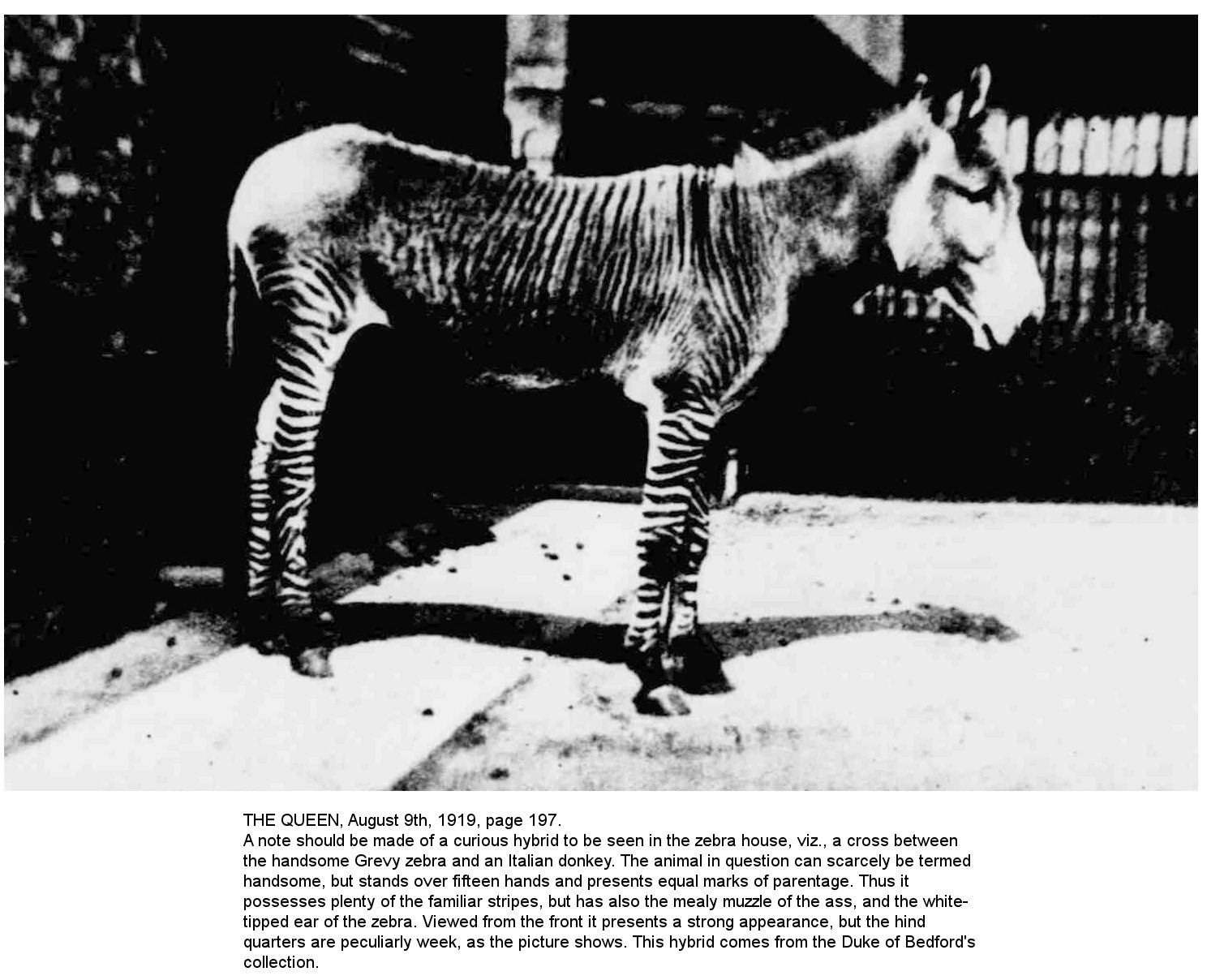
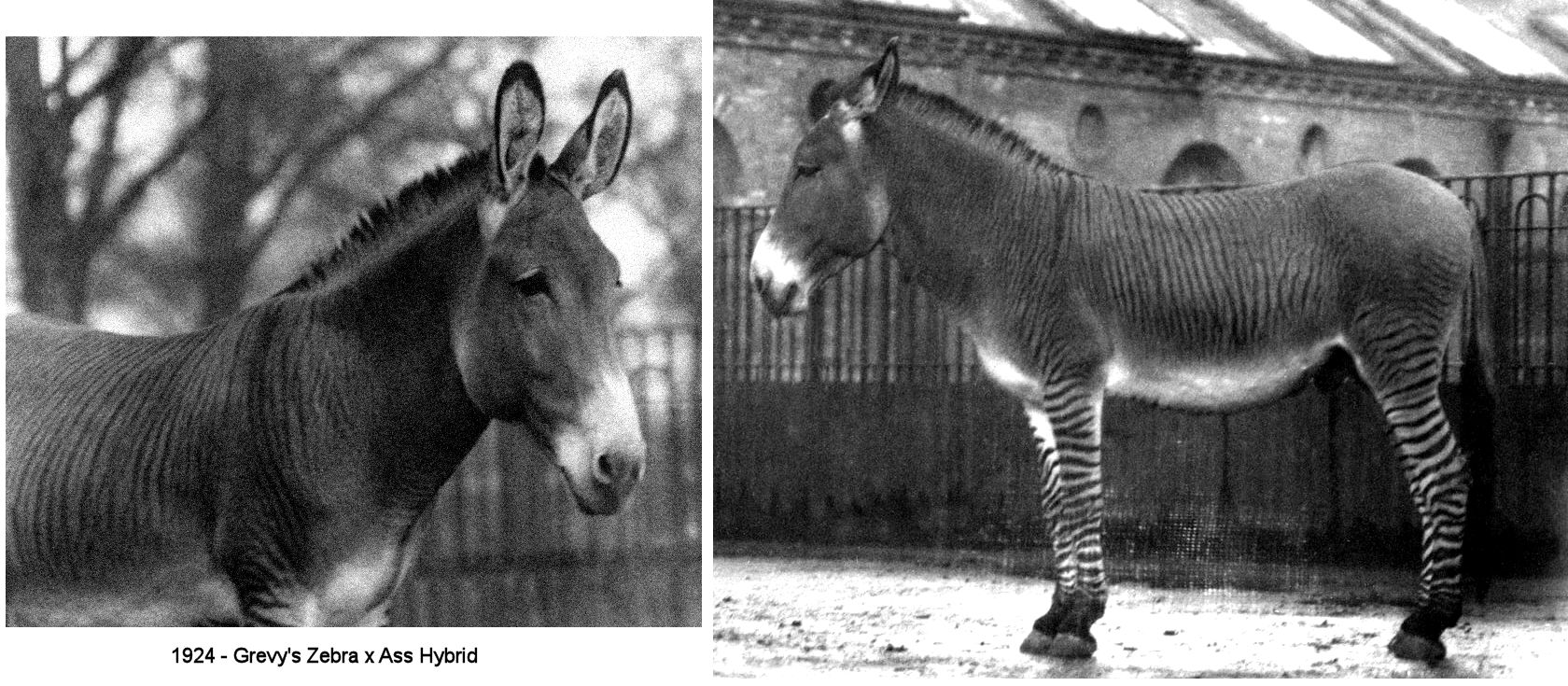
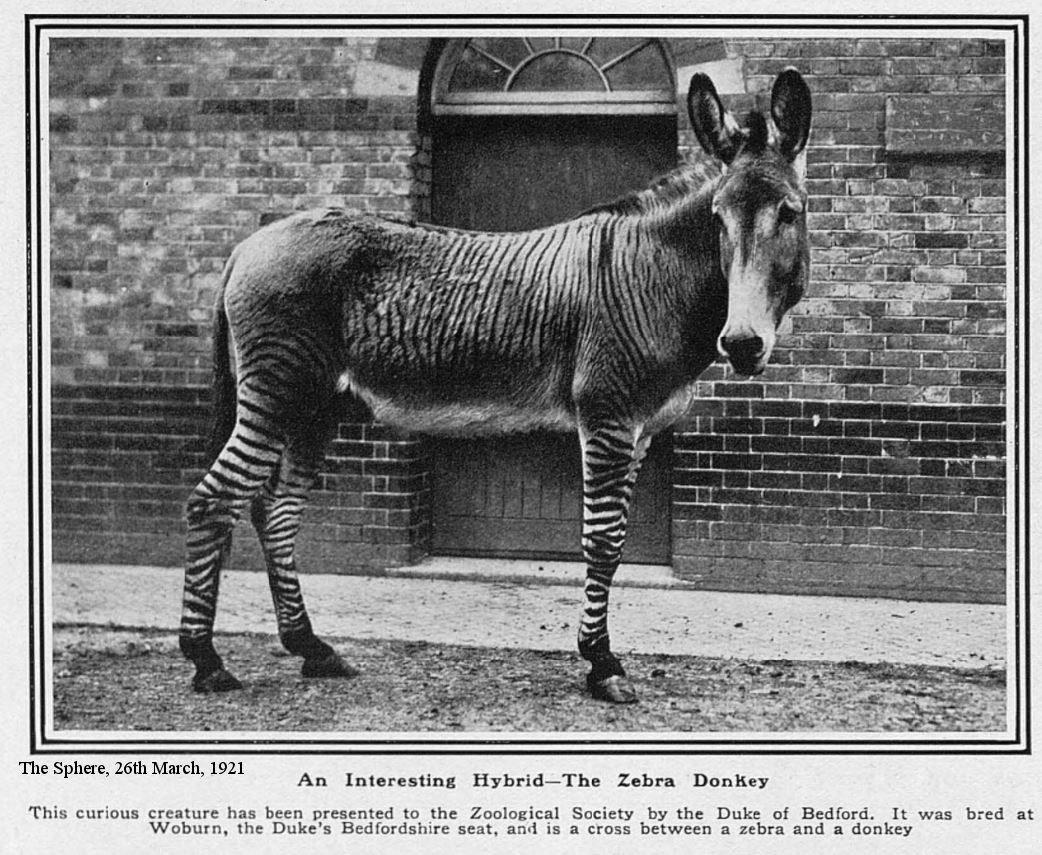
|
|
|
|
|
|
|
A Grevy s zebra stallion was presented to USA by King Menelik of Abyssinia. President Roosevelt. It lived at the National Zoo from 1904 to 1919 and was loaned for a while to the US Dept of Agriculture for use in cross-breeding experiments with horses and asses. At least some of the hybrid offspring went to Sells-Floto circus. Sells-Floto Circus advertised one of the hybrids as:A New Member Of The Animal Kingdom. A strange beast came into being a short time ago, and naturally it was the Sells-Floto Circus which seized upon it as thing of interest to the public at large That beast was the Hyney, a Government animal, now being exhibited with the Circus to show the wonderful results of the propagation and breeding of entirely different animals. For the parents of the Hyney were brought from widely separated parts of the earth. After years of experiments, in which attempts were made to cross the zebra with some other beast that might give it value as a domestic animal, the United States Government, through its division of husbandry and animal industry, decided that the burro was the proper animal. And so a Grevy Zebra, of the Galla district of Africa, the fiercest and wildest of all types of zebra, was crossed with a Rocky Mountain Burro, known as the slowest and dullest and most sluggard animal of the horse species. The result was a success. And thus it is that a new animal enters into being the Hyney with a burro for a mother and a zebra for a father. The combination is perfect. As fleet, as graceful as a horse, yet the Hyney has all the strength and working power of a mule. As intelligent as its zebra forebear, still it has the docility of its burro ancestors. Five of the animals are exhibited both in the menagerie and main performance of the Sells-Floto Circus, where the extent of their intelligence and their value as farm animals is well depicted.
|
|
Two zebroids drawing a cart in 1915 |
Airdrie & Coatbridge Advertiser [and many others], 8th July 1911: On Coronation Day [21st June] there was born at the Gardens a female foal, the father of which is the Somali wild ass, owned by the society, whilst the mother is a mountain zebra mare. The interest of this event, says the Times, was greatly increased by the birth last week [28th June] of a second donkey-zebra hybrid, also a female, the male parent being the same and the female a Chapman's zebra mare. Successful crosses between different species of zebra and horses or ponies have been made repeatedly, and the society possesses a characteristic example, bred in South Africa from a horse and a Chapman s zebra, and presented by the late king to the [zoological] gardens.
Globe, 8th July 1911: NOTES FROM THE ZOO. Two other interesting additions to the menagerie consist of a couple of donkey-zebra foals, representing several attractive points for the study of reflective naturalists. The father of the first foal is a Somali wild ass, while the mother is mountain zebra mare. In the second case the male parent is the same, the mother being a Chapman's zebra. These are somewhat rare crosses, being bred less frequently than those between the horse, and its much-striped cousin the African plains. The little zebra-asses take distinctly after their father in shape, while their hides are reddish fawn, much lighter below, and the whole body marked by clearly defined stripes of darker colour. A curious point is that though these foals possess the black marks on spine and shoulder seen in the common donkey, their sire, the wild ass. does not own any such markings.
Illustrated London News, 1924: Mr. R. I. Pocock some years ago published some interesting facts in regard to zebra-ass hybrids, born in the Gardens of the Zoological Society. Here the sire was a Somali wild ass, the dam a mountain zebra. The foal closely resembled her sire, which, of course, was unstriped, save on the legs. But the legs of the foal were much more strongly striped than the sire, and there were faint stripes on the head and neck, and very strongly marked shoulder-stripe, which is not present in the sire. A second foal, by the same sire, out of a Burchell s zebra of the race known as Chapman s quagga, was very like the mountain zebra hybrid, but the ears were relatively shorter and the striping less distinct, even on the legs. The shoulder-stripe was decidedly shorter, and the stripes on either side were fainter. Asinine were dominant over zebrine characteristics in this animal. In the case these zebra-horse and zebra-ass hybrids, it is to be noticed, the coloration of the foals differed from the pure-bred parents - where these were zebras and showed a reversion to the coloration of more remote ancestor, apparently closely resembling the Somali zebra.
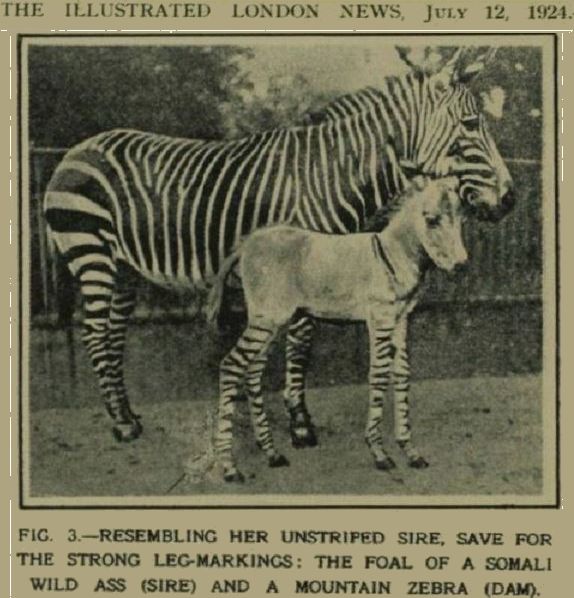
An article from New York Times, June 16th, 1973, announced the birth of a zebra/donkey hybrid at the Jerusalem Zoo. They called it a "hamzab" from the Hebrew for donkey-zebra and erroneously claimed it to be the first of its kind born anywhere. A breeding programme at Colchester Zoo, England in 1975 produced three zedonk hybrids from Arabian Black Ass mares and A Chapman's Zebra stallions. In Christmas week of 1975 their third zedonk foal was born. Previous attempts at crossbreeding zebras with horses and donkeys had failed to produce surviving foals. The zoo's aim was to produce disease-resistant work-horses for Africa. Colchester Zoo experts believed their success was due to the use of an Arabian donkey (a variety not tried before in hybridization experiments) and had hoped that the hybrids would be viable and fertile. Their last surviving zedonk, Shadow, died in April 2009 aged 34. She shared an enclosure with zebras, but did not socialise with them. In latter years, the zoo tried to dissociate itself from the hybridisation programme by claiming the zedonks were the result of accidental matings, but contined to claim they'd bred the first ever zedonks, despite the hybrids being bred over 100 years earlier.
The Chestatee Wildlife Preserve in Georgia, U.S. had its own zonkey on July 21, 2010. A donkey sanctuary in Shropshire has a zorse called Zulu, a zedonk called Zambi, and a zebra hinny called Zee (the latter results from a donkey stallion and zebra mare). The sanctuary does not condone breeding zebroids, but had rescued the three hybrids which had been bred in the USA where donkey/zebra and horse/zebra crosses are bred on several ranches as exotic riding or driving animals.
Ippo the 'Zonkey' was born after a zebra stallion climbed out of his enclosure to mate with an endangered donkey at an animal reserve in Florence, Italy. The sire had been rescued from a failing zoo. The mother was a Donkey of Amiata, an endangered species, in a neighbouring field.
|
|
|
|
Usually a zebra stallion is paired with a horse mare or ass mare, but in 2005, a Burchell's zebra named Allison produced a zebrass (a zebret ) called Alex sired by a donkey at Highland plantation in St. Thomas parish, Barbados.
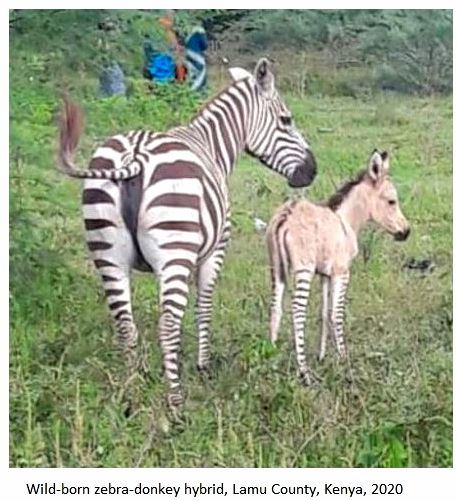
WILD-BORN ZEBRA-DONKEY HYBRIDS
Zebra-Donkey and Zebra-Horse hybrids occasionally occur when a female domestic donkey or horse strays and joins up with a herd of zebras and mates with the zebra stallion. In December 2020, a female zebra produced a zonkey in Moa village, Witu Division of Lamu County, Kenya. The zebra mare had been living in the compound of area chief Abdi Bocha since 2019 and was believed to have strayed from Boni Forest. Being a herd animal, it grazed with domestic donkeys, cows, goats, and sheep, and mated with its closest relative a donkey stallion. The villagers saw it got on well with the donkeys so they didn t chase it away.
Local people are encouraged to be hospitable to harmless wild animals such as zebras, which would normally leave the area after a short time. Wildlife officials gave the family permission to take care of the zebra and her hybrid foal on their homestead. Such cases are not unique. There have been cases of zebras giving birth to half-donkeys, half-zebras in places like Maralal. A zonkey was seen at the Tsavo East National Park in Kenya earlier in April 2020; its zebra mother having strayed out of the national park and into a neighbouring village where she grazed with some local cattle and mated with a village donkey. That zebra and zonkey foal were transferred to the Chyulu National Park, where they thrived due to plentiful vegetation and few predators. Being sterile, the zonkeys pose no genetic threat to wild zebras.
A mysterious zebra-donkey hybrid (zedonk or zonkey) produced under natural mating: A case report from Borana, southern Ethiopia - B. Megersa, D. Biffa and B. Kumsa, University of Hawassa, Faculty of Veterinary Medicine, Awassa, Ethiopia. Animal Production Research Advances 2 (3): 148-154, 2006
This was the first natural zebra-donkey hybrid recorded in Ethiopia. In 2004, a female plains zebra had become separated from its herd and joined the donkey herds at Madadunun village (about 35 km Northeast of Nagelle Borana town), Southern Ethiopia. A male donkey mated with the zebra mare, resulting in two male hybrids produced about 2 years apart. At maturity, the F1chybrids were captured and trained, albeit with difficulty due to their temperament and strength. The F1 hybrids were larger, stronger and tougher than either parents, making them useful working animals. One hybrid was sold, and the dam unfortunately died, but the other hybrid was kept by the original owner and used for transportation, draught and – surprisingly - breeding. Although equine hybrids are generally considered sterile, especially males, the F1 male hybrid sired two offspring.
The F1 hybrid was larger than the local donkey stallions, with a more zebra-like build and a pony-like body appearance. In common with other zebra-donkey hybrids it had a dun/brown body with faint stripes, facial stripes, prominent leg stripes, and the dorsal stripe and shoulder stripe of a donkey. Its size was probably a mix of hybrid genetics plus the larger womb of a zebra mare compared to a donkey mare (captive bred zebra-donkey hybrids generally use a zebra stallion with a donkey mare).
The F1 hybrid showed donkey-like courtship and mating behaviour, high libido and frequent and prolonged mating. The high libido combined with poor fertility resulted in donkey mares becoming exhausted from frequent mating. It was aggressive towards donkey stallions and injured several when fighting over a donkey mare in oestrus. The owner evidently hoped to breed from it because of its greater strength and endurance. The F1 hybrid sired two offspring on two different donkey mares. One was examined by the researchers and found to be healthy; it resembled a donkey foal except for black stripes on the limbs. The owner of the F1 hybrid, having realised the animal was poorly fertile, was exhausting donkey mares and injuring the donkey stallions, stopped using it for breeding. The chromosomes of the F1 and F2 hybrids were not examined.
DARWIN ON HYBRID EQUIDS
In "Origin of Species" (1859) Charles Darwin mentioned four coloured drawings of hybrids between the ass and zebra. He noted "In Lord Moreton's famous hybrid from a chestnut mare and male quagga, the hybrid, and even the pure offspring subsequently produced from the mare by a black Arabian sire, were much more plainly barred across the legs than is even the pure quagga. Lastly, and this is another most remarkable case, a hybrid has been figured by Dr. Gray (and he informs me that he knows of a second case) from the ass and the hemionus." Darwin described the latter hybrid in "The Variation Of Animals And Plants Under Domestication": The Equus indicus [onager] a hybrid, raised at Knowsley ('Gleanings from the Knowsley Menageries' by Dr. J.E. Gray.) from a female of this species by a male domestic ass, had all four legs transversely and conspicuously striped, had three short stripes on each shoulder and had even some zebra-like stripes on its face! Dr. Gray informs me that he has seen a second hybrid of the same parentage, similarly striped.
In his "The Variation Of Animals And Plants Under Domestication", Darwin wrote: "I have seen, in the British Museum, a hybrid from the ass and zebra dappled on its hinder quarters. [...] Many years ago I saw in the Zoological Gardens a curious triple hybrid, from a bay mare, by a hybrid from a male ass and female zebra. and further described Moreton's hybrid; In the famous hybrid bred by Lord Morton ('Philosoph. Transact.' 1821 page 20.) from a chestnut, nearly purely-bred, Arabian mare, by a male quagga, the stripes were "more strongly defined and darker than those on the legs of "the quagga." The mare was subsequently put to a black Arabian horse, and bore two colts, both [...] plainly striped on the legs, and one of them likewise had stripes on the neck and body.
In that book, Darwin concluded: "The ass has a prepotent power over the horse, so that both the mule and the hinny more resemble the ass than the horse; but that the prepotency runs more strongly in the male-ass than in the female, so that the mule, which is the offspring of the male-ass and mare, is more like an ass, than is the hinny, which is the offspring of the female-ass and stallion." In "The Variation Of Animals And Plants Under Domestication" Darwin elaborated: "Colin, who has given in his 'Traite Phys. Comp.' tome 2 pages 537-539, [...] is strongly of opinion that the ass preponderates in both crosses, but in an unequal degree. This is likewise the conclusion of Flourens, and of Bechstein in his 'Naturgeschichte Deutschlands' b. 1 s. 294. The tail of the hinny is much more like that of the horse than is the tail of the mule, and this is generally accounted for by the males of both species transmitting with greater power this part of their structure; but a compound hybrid which I saw in the Zoological Gardens, from a mare by a hybrid ass-zebra, closely resembled its mother in its tail.)"
In "Darwinism An Exposition Of The Theory Of Natural Selection With Some Of Its Applications" (1889), Alfred Russel Wallace commented: "Crosses between the two species of zebra, or even between the zebra and the quagga, or the quagga and the ass, might have led to a very different result."

CHROMOSOME STUDIES OF ZEBRA-ASS HYBRIDS
According to An introduction to mammalian interspecific hybrids by R V Short in J Hered, 1997 Sep-Oct;88(5):355-7.
"The recent identification, mapping, and sequencing of the sex-determining gene on the mammalian Y chromosome, SRY, has shown that it shows great interspecific variability" which suggests that this is why males (XY) are sterile, but females (XX) may be fertile. In the case of the mule (male donkey x female horse) and hinny (male horse x female donkey), it seems highly probable that the genes on the donkey's Y chromosome will have diverged significantly from those on the horse's Y chromosome. The donkey's SRY gene may therefore be only partially successful in inducing testicular development (and the converse for male hinnies).
Many XY mules form testes and develop as phenotypic males, but either produce no sperm or abnormal sperm. Meanwhile many female mules lack oocytes in their ovaries. This is usually attributed to the chromosomes from each parent being unable to pair up. There are several possible reasons why no fertile male mules or hinnies have been reported, but several female mules and hinnies have proven fertile.
Are there any consistent phenotypic or behavioural difference between mules and hinnies? If so, these might be explained by the exclusively maternal inheritance of mitochondrial DNA, or by the maternal genome being preferentially expressed in the embryo and the paternal genome in the placenta. If this were the case, it would make mules more horse-like and hinnies more donkey-like. Behavioural and vocalisation difference might be related to genetics and/or the foal learning from its mother. In addition, male donkey x female horse mating are more likely to produce offspring than the reciprocal mating. Perhaps horse sperm is less able to penetrate donkey ova.
Pooling strategy and chromosome painting characterize a living zebroid for the first time. - Iannuzzi A, Pereira J, Iannuzzi C, Fu B, Ferguson-Smith M (2017) PLoS ONE 12(7): e0180158.
Chromosomal rearrangements had previously been considered the main reason for hybrid sterility. However, the main underlying cause, seems to be a difficulty in the pairing of two chromosomes that allows matching-up of homologous pairs and possible chromosomal crossover prior to gamete (egg & sperm) formation. This results in non-homologous recombination during gamete production. Non-homologous recombination is where two unrelated double stranded segments of DNA are joined. Genetic material gets inserted into the DNA in places where it isn't meant to be. This leads to genes being broken so that the protein they encode for is not properly expressed.
At the time of the study there were there were four living zebra-donkey hybrids exist in different parts of the world: Italy (male foaled by a donkey), Mexico (male foaled by a zebra), China (female foaled by a zebra) and Georgia (female foaled by a donkey). All resulted from natural mating, not artificial insemination. The researchers studied the chromosomes of the Italian male zebroid born to a donkey that had mated with a zebra in an Italian animal rescue centre close to Florence in July 2013. The hybrid appeared healthy, with no obvious malformations, and was raised by its donkey mother.
The somatic (non reproduction) cells of the hybrid revealed a 2n = 53, XY karyotype. It had inherited a haploid set of chromosomes from each of its parents without evidence of chromosome rearrangement. The diploid chromosome count was 53 and different chromosomes were derived from each parent, presumably 22 from the zebra and 31 from the donkey. The hybrid had received a precise haploid set of chromosomes from each parent without rearrangement. The researchers assumed the sterility of the zebroid was due to the very complex chromosomal organization and planned to study sperm chromosome segregation when it reached sexual maturity.
Textual content is licensed under the GFDL.
|
BACK TO HYBRIDS & MUTANTS INDEX INDEX |